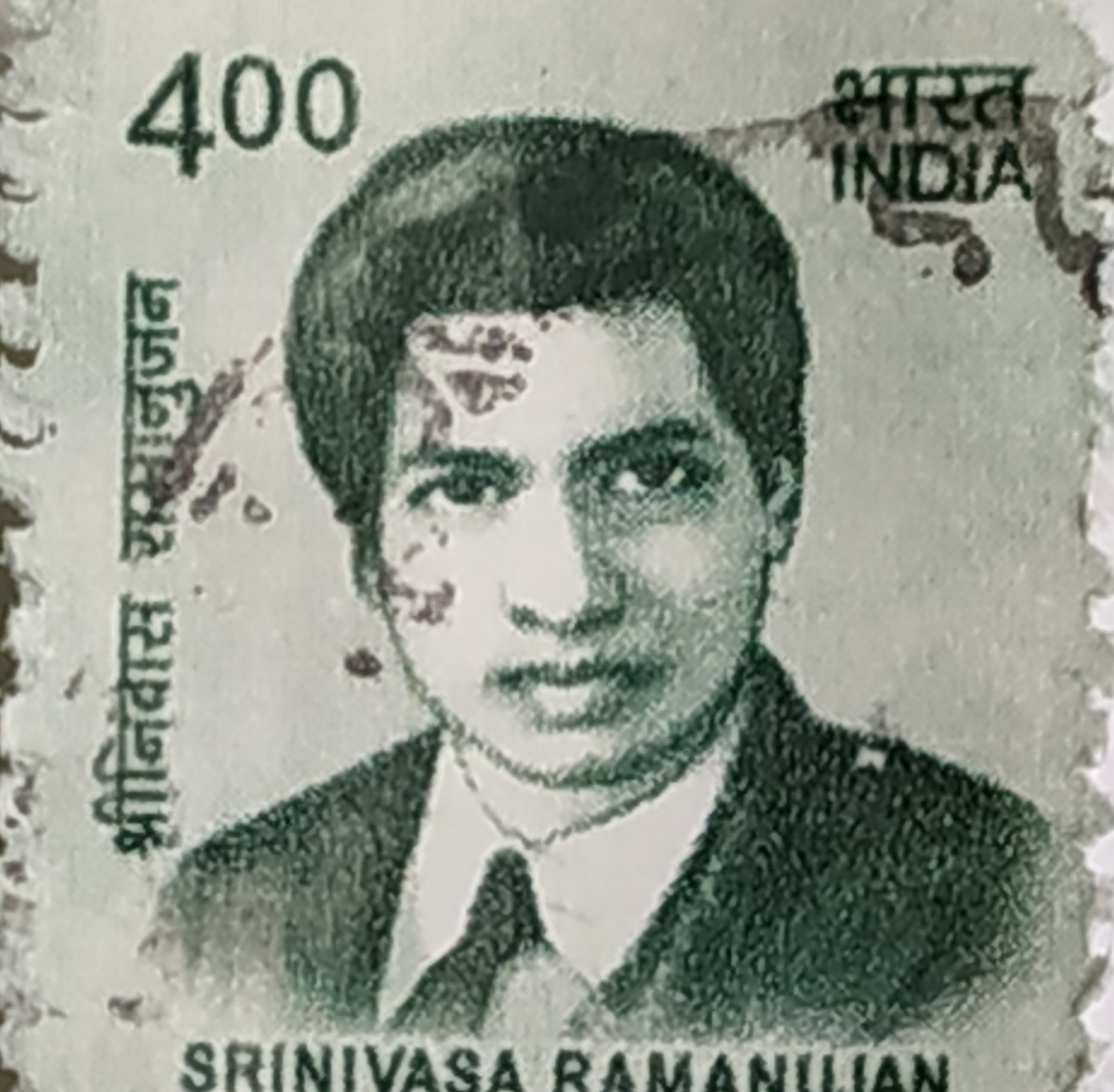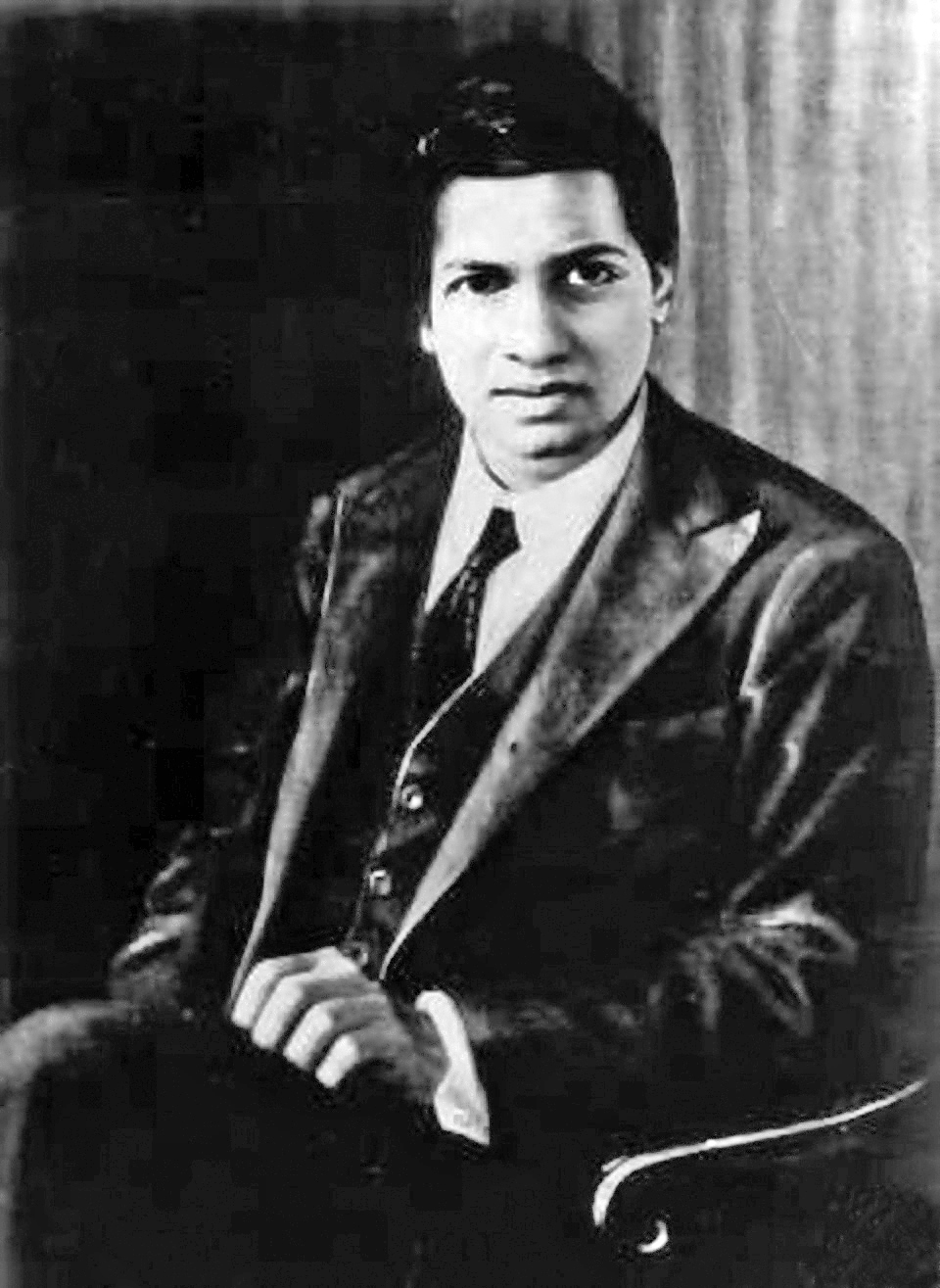Srinivasa Ramanujan
Legacy of Srinivasa Ramanujan and India’s Vedic Sciences
Srinivasa Ramanujan was a genius. Srinivasa Ramanujan’s remarkable journey in the field of mathematics is deeply rooted in the rich cultural and scientific heritage of India—a land where ancient wisdom and Vedic sciences flourished long before the modern era. Born in the small town of Erode, Tamil Nadu, on December 22, 1887, Ramanujan’s prodigious talent in mathematics bloomed from the soil of a civilization that had measured the heavens and computed the circumference of the Earth with astonishing precision. In a culture that had conceptualized advanced mathematical ideas and erected monumental structures like the Sun Temple, Ramanujan’s genius seemed almost predestined.
The son of a Brahmin family, Ramanujan’s early affinity for numbers outshone the traditional educational framework, propelling him into a world of infinite series, number theory, and complex mathematical analysis. His instinctive grasp of mathematics drew from the deep wells of India’s scientific sagacity, echoing the work of scholars who had pondered the value of pi and laid out geometric principles akin to the Pythagorean theorem centuries before the West. This essay delves into the life of a mathematical savant who, while drawing from the ancient springs of Vedic knowledge, leaped into the realm of eternal mathematical truth. We embark on a journey through Ramanujan’s early struggles, his pivotal collaboration with G.H. Hardy, and his remarkable contributions that still resonate in the mathematical continuum.
Early Life and Education of Srinivasa Ramanujan
Srinivasa Ramanujan was born on December 22, 1887, in the town of Erode in Tamil Nadu, India. His family was of Brahmin lineage, and his father worked as a clerk in a cloth merchant’s shop. From a very young age, Ramanujan exhibited a prodigious aptitude for mathematics. His academic prowess became evident when he exhausted the mathematical knowledge of his teachers at Kumbakonam’s Town High School by the age of 11. By 13, he had mastered advanced trigonometry and began to explore complex mathematical research on his own.
Despite his brilliance, Ramanujan’s fixation on mathematics led to difficulties in other subjects, causing him to fail non-mathematical subjects in college. His intense dedication to mathematics meant that he often neglected his other studies, and this singular focus resulted in his loss of a scholarship and his eventual withdrawal from college. Nevertheless, Ramanujan continued his mathematical pursuits independently, developing his theories without formal guidance or access to the broader mathematical community of his time.
Mathematical Genius Evident
Ramanujan’s early mathematical work began to take shape through notebooks filled with theorems, many without proofs, which were results of his intense and isolated study. His work included sophisticated calculations and results that would later be seen as laying the groundwork for future research in number theory.
Without a university degree, Ramanujan faced significant hurdles in gaining recognition in the academic community. However, his persistence paid off when he started to send samples of his theorems to academics at the University of Madras. Initially, he was met with indifference, but his talent eventually earned him both financial aid and academic attention. This support allowed him to publish his work in the “Journal of the Indian Mathematical Society,” which helped establish his reputation as a mathematician of extraordinary ability.
Ramanujan’s contributions to Indian mathematical journals showcased not just a natural talent but also a unique approach to mathematics. His results were often arrived at through intuition and presented without proof, which both puzzled and fascinated other mathematicians. These journals were his platform for sharing discoveries that included properties of Bernoulli numbers and the partition function, work that would soon capture the attention of mathematicians in Europe and lead to a pivotal turning point in his life: his correspondence and eventual partnership with G.H. Hardy at Cambridge.
Collaboration with G.H. Hardy
The collaboration between Srinivasa Ramanujan and G.H. Hardy began with a leap of faith. In 1913, Ramanujan, working as a clerk in Madras, mustered the courage to send a letter to Hardy at Cambridge, enclosing a sheaf of theorems. Hardy, initially skeptical, soon recognized the brilliance in Ramanujan’s work, later describing his formulas as “scarcely possible to believe.” Overcoming his initial doubts, Hardy invited Ramanujan to Cambridge, marking the commencement of a legendary partnership in the annals of mathematics.
Upon Ramanujan’s arrival in Cambridge in 1914, the collaboration flourished, with Hardy acting as both mentor and collaborator. They delved into deep mathematical research, publishing numerous papers that spanned various complex domains. Among their most significant works were papers on the asymptotic analysis of partitions, which led to the formulation of the famous Hardy-Ramanujan asymptotic formula, a result that beautifully melds analysis and number theory. Their partnership was not only productive in terms of output but was also a profound meeting of minds, bringing together Hardy’s formal, rigorous approach and Ramanujan’s intuitive, almost mystical insights.
Notable Mathematical Contributions
Ramanujan’s contributions to mathematics are vast and varied, touching upon many areas and leaving a legacy that researchers continue to explore. His work on infinite series, for instance, is legendary, particularly his summations of hypergeometric series and his uncanny ability to find formulas for the calculation of pi that were both fast-converging and elegant.
Another significant area of Ramanujan’s work was his exploration of continued fractions. His findings in this area are among the most beautiful and surprising in mathematical literature. They are not only of theoretical interest but also have practical applications in computing and number theory.
Perhaps one of the most remarkable aspects of Ramanujan’s mathematical legacy is his work on modular forms and q-series. His conjectures, posthumously proven, have led to the development of the field of modular forms, with implications affecting string theory and black hole physics. This includes his famous “mock theta functions,” which have been a source of mystery and inspiration. These functions, found in the last year of his life, were only fully understood with the advent of modern mathematical theory, reflecting Ramanujan’s work’s depth and foresight.
In addition to these, Ramanujan’s work on the partition function p(n), which describes the number of distinct ways a given positive integer n can be expressed as a sum of positive integers, has led to extensive developments. His formulation of congruences for the partition function was groundbreaking and spurred further research that continues to bear fruit in contemporary mathematics.
Challenges and Struggles
Srinivasa Ramanujan’s transition from the warm climate of India to the cold, damp environs of England brought about a cascade of challenges that affected both his personal and professional life. Professionally, he found himself in a world where mathematical rigor and proofs were the norm, a significant shift from his intuitive approach to mathematics. Personally, he grappled with severe homesickness, difficulties related to his strict vegetarian diet, and a sense of isolation due to cultural barriers.
Ramanujan’s health deteriorated sharply during his time in England. The onset of World War I made life even more challenging, as resources became scarce and communication with his family in India grew infrequent and uncertain. The wartime environment added a layer of stress and hindered the academic atmosphere, impacting the collaboration and exchange of ideas necessary for a mathematician’s growth.
Despite these adversities, Ramanujan’s mathematical output remained prolific. However, the combined strain of professional pressures and personal issues eventually led to a serious breakdown in health, which was diagnosed as tuberculosis and a severe vitamin deficiency. This condition would plague him for the rest of his life, leading to his return to India in 1919.
Addressing Systemic Barriers in Ramanujan’s Career
Further complicating Ramanujan’s professional journey were the broader systemic barriers that he faced as a mathematician from a colonized country during the early 20th century. The global scientific community was not insulated from the biases that stemmed from colonial attitudes and Eurocentric perspectives, often manifesting in the underrepresentation and underrecognition of scholars from non-European nations in international academic circles and accolades.
Ramanujan’s initial overtures to British mathematicians met with skepticism, a likely reflection of the prevailing biases of the time. His contributions, while groundbreaking, were initially seen as unconventional within the conservative academic frameworks of the West. However, the eventual recognition of his talents by G.H. Hardy and others not only marked a significant personal victory for Ramanujan but also highlighted the need for the academic community to embrace a more inclusive and equitable approach to recognizing talent and genius, irrespective of geographical and cultural origins.
Ramanujan’s story thus not only underscores the personal resilience required to overcome immediate adversities but also serves as a powerful narrative on the need to challenge and overcome systemic barriers in the pursuit of knowledge and recognition in the global scientific arena.
Ramanujan Conjecture and Later Discoveries
One of the most significant contributions Ramanujan made to mathematics was his conjecture on the properties of tau-functions, now famously known as the Ramanujan Conjecture. Proposed in 1916, the conjecture was related to the coefficients of the q-expansion of the modular discriminant Delta function. This work speculated profound relationships between these coefficients, foreshadowing deep connections within number theory, and was later proven by Pierre Deligne as part of his proof of the Weil conjectures, work that ultimately won Deligne a Fields Medal.
Ramanujan’s conjectures laid the groundwork for the field of modular forms and representation theory. They have influenced countless areas of mathematics and even seeped into physics, with connections to the theory of black holes and quantum gravity. His investigations into mock theta functions, which he described in the last year of his life, were initially a mystery to mathematicians. However, they are now central to the study of modular forms, with the subject undergoing significant development in the late 20th and early 21st centuries, leading to what some call the ‘mock modular forms revolution.’
Ramanujan’s explorations continue to inspire a wealth of mathematical discoveries and advancements. The Ramanujan Conjecture and his profound work in various realms of mathematics have been a beacon, guiding the study of complex patterns, symmetries, and the inherent order within seemingly chaotic number systems. His legacy in the mathematical sciences is marked by these deep conjectures, many of which mathematicians continue to unpack and understand, cementing Ramanujan’s role as an eternal scholar of the mathematical universe.
Final Years and Untimely Death
In 1919, a seriously ill Ramanujan returned to India, where the climate was more amenable to his frail condition. Despite his failing health, he did not cease his mathematical pursuits. During this time, he compiled a significant amount of work, including his last letter to Hardy, which contained a list of mock theta functions that mathematicians would study for decades to come. Ramanujan’s passion for mathematics burned bright, as he produced deep results and theorems that would only be fully understood many years later.
Ramanujan’s health, however, continued to decline. The exact nature of his illness has been a subject of debate, with some modern researchers suggesting it might have been hepatic amoebiasis, a condition that could have been treated with appropriate medical intervention. Tragically, his condition was misdiagnosed and mistreated. On April 26, 1920, at the age of 32, Ramanujan succumbed to his illness. His premature death sent ripples through the mathematical community. Tributes poured in from around the world as news of his passing spread, and he was mourned as a mathematician whose profound contributions were cut short at their prime.
Mathematical Community’s Reaction to His Death:
“To further understand the impact of Ramanujan’s untimely death at the age of 32, it’s important to consider the immediate reaction from the global mathematical community. Upon his passing in 1920, the Royal Society, of which he was a Fellow, and other academic institutions around the world, expressed their deep loss through obituaries and memorials that highlighted his incredible contributions under such limited conditions. Eminent mathematicians like Hardy expressed profound grief, noting that the most romantic figure in the recent history of mathematics had passed away. Such testimonials underscored the magnitude of his loss to the field, reflecting on how much more he might have achieved had he lived longer. This discussion would provide a more rounded picture of his impact at the time and the void his early death left in the mathematical world.
Legacy and Posthumous Recognition of Srinivasa Ramanujan

The legacy of Ramanujan is celebrated both in India and globally. The Government of India declared his birthday, December 22, as National Mathematics Day to honor his contributions to the field of mathematics. Additionally, the Srinivasa Ramanujan Institute for Basic Sciences in Kerala, the Ramanujan Mathematical Society, and the SASTRA Ramanujan Prize are all named in his honor, celebrating young mathematicians who continue his tradition of excellence.
Internationally, his life and work have been commemorated in various ways, including the establishment of the Ramanujan Journal, which is dedicated to areas of mathematics influenced by his work. Moreover, in a fitting tribute to his partnership with Hardy, the University of Madras and Trinity College, Cambridge, collaborate to host the Hardy-Ramanujan Journal.
Ramanujan’s story transcends mathematics, inspiring books, plays, and a film that explore the brilliant life and the poignant struggles of this mathematical genius. His life serves as a testament to the enduring nature of intellectual curiosity and the pursuit of knowledge against all odds. The honors and recognitions bestowed upon Ramanujan are a reflection of the universal appreciation of his intellectual legacy, which continues to enlighten and inspire.
Ramanujan’s Enduring Influence in Modern Mathematics

The influence of Srinivasa Ramanujan on modern mathematics is profound and pervasive, continuing to inspire contemporary mathematicians around the world. His work, characterized by its depth and originality, has seeded areas of mathematical research that are still fertile grounds for exploration. Today, Ramanujan’s findings are not just historical footnotes but are integral to ongoing advancements in fields such as number theory, modular forms, and even in the realms of physics like string theory and quantum gravity.
Contemporary mathematicians regard Ramanujan’s contributions as foundational, often marveling at his intuitive grasp of complex mathematical concepts that were far ahead of his time. His extensive work on partitions, for instance, has evolved into essential tools for studying symmetry, combinatorics, and algebraic structures. Moreover, Ramanujan’s notebooks—filled with theorems, formulas, and conjectures—are still being deciphered, revealing new insights and inspiring fresh lines of inquiry into the nature of numbers and their relationships.
Reflections of Srinivasa Ramanujan and his Journey
Srinivasa Ramanujan’s intellectual journey is a testament to the extraordinary capabilities of human thought and the enduring quest for knowledge. His life, from the modest surroundings in Erode to the scholarly halls of Cambridge, encapsulates a narrative of immense persistence, innate talent, and profound creativity. Ramanujan’s story is not merely about the triumphs of a mathematical genius but also reflects the universal spirit of inquiry and determination. His legacy teaches us that the pursuit of knowledge often requires both imagination and perseverance, and that barriers of geography and education can be transcended by sheer brilliance and passion for one’s field.
Ramanujan’s contributions remind us that mathematical creativity is not confined to the structured environment of academia but can flourish in any setting that nurtures curiosity and encourages exploration. His life encourages future generations to look beyond the apparent and explore the depths of the abstract, where the beauty of mathematics meets the mysteries of the universe.
Further Reading and Online Resources on Srinivasa Ramanujan
Books:
- The Man Who Knew Infinity by Robert Kanigel: A biography that provides a comprehensive look at Ramanujan’s life and work.
- Ramanujan: Letters and Commentary by Bruce C. Berndt and Robert A. Rankin: Features the famous letters between Ramanujan and Hardy and commentary on his work.
Online Resources:
- The Ramanujan Journal – An international publication dedicated to the areas of mathematics influenced by Ramanujan.
- Wolfram MathWorld – Provides entries on Ramanujan’s formulas and theories, detailed in an accessible format.
- Ramanujan Srinivasa Digital Archive – A digital archive maintained by Cambridge University that contains many of Ramanujan’s original papers and manuscripts.
Glossary of Difficult Terms
Modular Forms: A class of complex functions that are symmetric and have significant applications in number theory, combinatorics, and theoretical physics.
Mock Theta Functions: Functions invented by Ramanujan that resemble but do not fit the usual definition of theta functions, important in various areas, including number theory and combinatorics.
Partitions: In mathematics, a way of writing a number as the sum of positive integers. Ramanujan developed several theorems about partitions, significantly advancing the field.
Number Theory: A branch of pure mathematics devoted primarily to the study of the integers and integer-valued functions.
Quantum Gravity: A field of theoretical physics that seeks to describe gravity according to the principles of quantum mechanics, and where quantum effects cannot be ignored, such as near compact astrophysical objects where the forces of gravity are strong.
Feature Image: The image is a monochromatic, vintage photograph of a man, presumably Srinivasa Ramanujan, sitting with his body slightly turned towards the right and looking directly at the camera. He has a solemn expression and is dressed in formal attire, which includes a coat, a collared shirt, and a tie. His hair is parted on the side, and his hands are folded in front of him, resting on what appears to be a draped cloth or a covered object. (Click here to view the image) [Credit https://www.wikipedia.org]

Very nice post. I just stumbled upon your weblog and wanted to say that I’ve truly enjoyed browsing your weblog posts. In any case I will be subscribing to your feed and I’m hoping you write once more very soon!